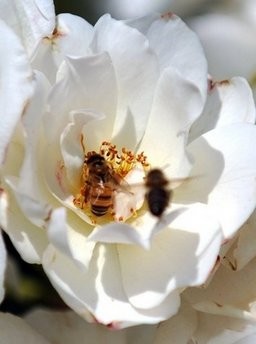The decline in the US bee population, first observed in 2006, is continuing, a phenomenon that still baffles researchers and beekeepers.
Data from the US Department of Agriculture show a 29 percent drop in beehives in 2009, following a 36 percent decline in 2008 and a 32 percent fall in 2007.
This affects not only honey production but around 15 billion dollars worth of crops that depend on bees for pollination.
Scientists call the phenomenon "colony collapse disorder" that has led to the disappearance of millions of adult bees and beehives and occurred elsewhere in the world including in Europe.

Researchers have looked at viruses, parasites, insecticides, malnutrition and other environmental factors but have been unable to pinpoint a specific cause for the population decline.
The rough winter in many parts of the United States will likely accentuate the problem, says Jeff Pettis, lead researcher at Department of Agriculture's Bee Research Laboratory in Beltsville, Maryland.
Winter figures will be published in April. But preliminary estimates already indicate losses of 30 to 50 percent, said David Mendes, president of the American Beekeeping Federation.
"There are a lot of beekeepers who are in trouble" he said.
"Under normal condition you have 10 percent winter losses.. this year there are 30, 40 to 50 percent losses."
He said the phenomenon probably results from a combination of factors but that the increased use of pesticides appears to be a major cause.
"I don't put my bees in Florida because the last couple of years there has been tremendous increase in pesticide use in the orange crop to fight a disease," he said.
"It's a bacterium and the only way to control this disease is to use pesticide... a few years ago they did not use any pesticide at all."
He said that pesticide use "has changed dramatically" and has made beekeeping "more challenging."
Research conducted in 23 US states and Canada and published in the Public Library of Science journal found 121 different pesticides in 887 samples of bees, wax, pollen and other elements of hives, lending credence to the notion of pesticides as a key problem.
Pettis said the finding of pesticide residue is "troubling."
"It might not be the only factor but it's a contributing factor," he said.
The best thing to help bees, he said its "to try to limit habitat destruction," leaving more natural areas in agriculture and in cities such so honey bees can have "a diverse natural environment."
Ironically, he said the problem stems from expansion of agriculture to feed the world. But in destroying bee populations, that can hurt crop production.
"The world population growth is in a sense the reason for pollinators' decline," he said.
"Because we need to produce more and more food to feed the world and we grow crops in larger fields. A growing world means growing more food and to do that we need pollinators. And the fact that the world is continuing to grow is the driving force behind the habitat destruction."
























